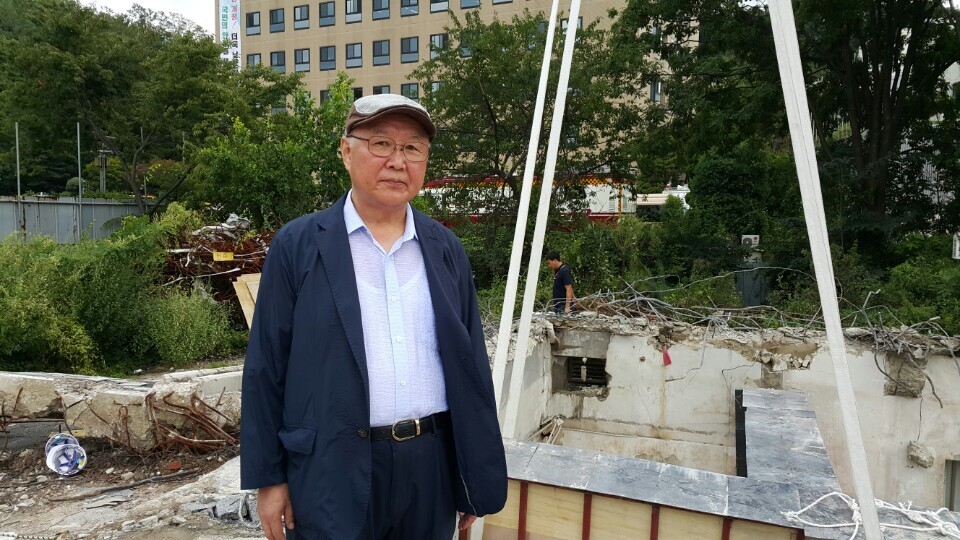hankyoreh
Links to other country sites 다른 나라 사이트 링크
Former KCIA “room of death” at Namsan opens to public

The basement of the former Korean Central Intelligence Agency (KCIA) Section 6 headquarters on Seoul’s Namsan Mountain - known as the “room of death” - was opened to the public on Aug. 16. As part of its plans to turn the Section 6 building into a plaza and exhibition hall recording a history of violence perpetrated by the state, the city of Seoul has been dismantling and reinstalling the basement to present it in its original state. On Aug. 16, the public was given a glimpse of the dismantling of the underground interrogation room where so much torture and violence occurred.
“There wasn’t anything there, just two desks. They would put a metal bar between them and hang a person upside down while they poured water on his face.”
As he watched Section 6’s dismantling, 68-year-old Choi Min-hwa went back in time to 43 years earlier. On the evening of Mar. 28, 1974, a blindfolded Choi, then a theology student at Yonsei University, was brought into Section 6. He had been fingered as a suspect in the Democratic Youth Student League case, but refused to give the names of the figures behind it. On the fourth day, he was taken to the room.
He still vividly recalled how the 30 square meter room looked. It was a big room with running water, and was mainly used for water torture or the so-called “roast chicken torture,” in which the victim had his or her hands and feet bound and was beaten.
To one side of the basement was a small, airtight room with two chairs in it, he explained. One of them was bolted to the ground so it would not move no matter how hard the victim struggled.
Choi was summoned to Section 6 around 30 times afterwards - more or less every time a political incident erupted. In the 1980s, he was taken to the anti-Communist branch office of the National Police Agency in Namyeong.
“While Namyeong was a space carefully set up for torture-based investigations from the outset, this [Section 6] was a loosely thrown-together setting for violence,” he remembered.
Speaking before the National Intelligence Service Truth and Reconciliation Commission in 2004, a former Section 6 investigator denied torture had taken place.
“The basement was crowded with boilers and machinery rooms. There was no room for torture to take place,” the investigator claimed.

But the people who had been taken there gave vivid testimony of what it actually looked like. At the time of the People’s Revolutionary Party (PRP) incident in 1975, it was used as a space for torture, with two sealed rooms, each reportedly resembling the large refrigerators used by butchers, with thick metal doors that did not open from inside.
Heo Jak, one of the PRP suspects taken into one of the two small rooms (each measuring just over 10 and 12 square meters), attempted suicide with a broken eyeglass lens after facing unendurable torture. Others were stomped on until they suffered hernias or lung abscesses.
The city of Seoul plans to dismantle the walls to the two rooms on Aug. 16 and relocate them for the Aug. 2018 opening of an exhibition center for the torture and interrogation chamber.
“The space will provide an answer as to how we should remember and preserve the legacy of the state violence,” said Seo Hae-seong, a planner for the “Memory 6” center.
By Nam Eun-joo, staff reporter
Please direct questions or comments to [english@hani.co.kr]

Editorial・opinion
![[Column] Has Korea, too, crossed the Rubicon on China? [Column] Has Korea, too, crossed the Rubicon on China?](https://flexible.img.hani.co.kr/flexible/normal/500/300/imgdb/original/2024/0419/9317135153409185.jpg) [Column] Has Korea, too, crossed the Rubicon on China?
[Column] Has Korea, too, crossed the Rubicon on China?![[Correspondent’s column] In Japan’s alliance with US, echoes of its past alliances with UK [Correspondent’s column] In Japan’s alliance with US, echoes of its past alliances with UK](https://flexible.img.hani.co.kr/flexible/normal/500/300/imgdb/original/2024/0419/2317135166563519.jpg) [Correspondent’s column] In Japan’s alliance with US, echoes of its past alliances with UK
[Correspondent’s column] In Japan’s alliance with US, echoes of its past alliances with UK- [Editorial] Does Yoon think the Korean public is wrong?
- [Editorial] As it bolsters its alliance with US, Japan must be accountable for past
- [Guest essay] Amending the Constitution is Yoon’s key to leaving office in public’s good graces
- [Editorial] 10 years on, lessons of Sewol tragedy must never be forgotten
- [Column] A death blow to Korea’s prosecutor politics
- [Correspondent’s column] The US and the end of Japanese pacifism
- [Guest essay] How Korea turned its trainee doctors into monsters
- [Guest essay] As someone who helped forge Seoul-Moscow ties, their status today troubles me
Most viewed articles
- 1[Column] The clock is ticking for Korea’s first lady
- 2Samsung barricades office as unionized workers strike for better conditions
- 3After 2 months of delayed, denied medical care, Koreans worry worst may be yet to come
- 4[Correspondent’s column] In Japan’s alliance with US, echoes of its past alliances with UK
- 5[Column] Has Korea, too, crossed the Rubicon on China?
- 6Hong Se-hwa, voice for tolerance whose memoir of exile touched a chord, dies at 76
- 7[Photo] Smile ambassador, you’re on camera
- 8All eyes on Xiaomi after it pulls off EV that Apple couldn’t
- 9[Guest essay] How Korea turned its trainee doctors into monsters
- 10US overtakes China as Korea’s top export market, prompting trade sanction jitters